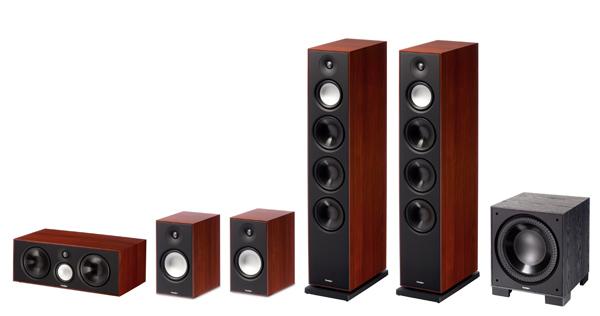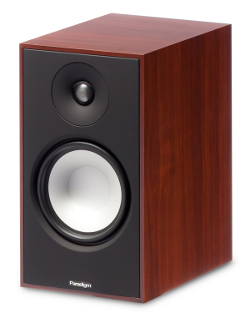Thanks for the great review. Been listening to speakers locally. I like the Paradigm Monitor 11 best so far. Also been reading the great reviews of the Aperion Verus Grands. How do these two compare head to head. I will certainly use them for movies but my primary concern is music. I listen to primarily rock.
Paradigm Monitor 11 Speaker System

AT A GLANCE
Plus
Crisp, powerful bass
Superior speaker-to-speaker timbre match
Excellent value
Minus
Slightly tipped-up highs
THE VERDICT
An immensely satisfying speaker system with both music and movies.
Canadian speaker manufacturer Paradigm makes a bewildering variety of loudspeakers. Its offerings top out at around $9,000 for a two-channel pair of Signature S8s—remarkably sensible considering the recent and alarming inflation in high-end audio prices. But while the speakers that make up the Paradigm’s Monitor Series 7, latest version of the company’s long-lived, bread-and-butter line, are far less expensive, they’re anything but an afterthought.
In late 2011, Home Theater reviewed a system from the Monitor Series 7 using a quintet of the second smallest model in the range—the Mini Monitor. But I’ve long been anxious to have a listen to the big brother in the Monitor 7 family, the Monitor 11, reviewed here with the Monitor SUB 12 and the Center 3. The Mini also shows up in this system as well, this time guest-starring as the surrounds. Paradigm also makes two bidirectional dedicated surrounds for the Monitor Series 7 range (not reviewed here).
Looks Like
 While the Monitor Series 7 speakers are essentially budget designs, there’s nothing skimpy in their appearance. They’re refreshingly businesslike, free of excess bling, and available finished in either Black Ash or Heritage Cherry grained vinyl. The cherry on our samples could easily pass for real wood. The game was given away only by the vinyl wraparound on the back edges—neat enough, but atypical of genuine veneer. (The SUB 12 comes only in a less attractive Black Ash.) The speaker sits on a plastic “Roman plinth” that enhances the narrow cabinet’s appearance and stability.
While the Monitor Series 7 speakers are essentially budget designs, there’s nothing skimpy in their appearance. They’re refreshingly businesslike, free of excess bling, and available finished in either Black Ash or Heritage Cherry grained vinyl. The cherry on our samples could easily pass for real wood. The game was given away only by the vinyl wraparound on the back edges—neat enough, but atypical of genuine veneer. (The SUB 12 comes only in a less attractive Black Ash.) The speaker sits on a plastic “Roman plinth” that enhances the narrow cabinet’s appearance and stability.
The Monitor 11 is the flagship of the range. It’s a relatively compact, five-driver, three-way, rear-ported design. Its 1-inch tweeter’s pure aluminum dome (PAL, a Paradigm trademark) replaces the titanium domes used in earlier generations of the Monitor Series. The dome sits at the apex of a short waveguide said to provide superior dispersion. The 5.5-inch satin anodized aluminum cone midrange (S-PAL) is housed in a dedicated, glass-reinforced polymer chamber to isolate it from the back waves of the three 6.5-inch woofers. The latter, all covering the same range, have carbon-infused injection-molded propylene cones. The lower crossover is second order at 700 hertz, the upper third order at 2.2 kilohertz.
The 0.75-inch baffles of the Monitor 11 (universal across the Monitor Series 7 line) conceal the drivers’ attachment hardware and present such an attractive face to the outside world (at least to me) that I didn’t have the heart to use the magnetically attached grilles. In any case, for me most speakers sound better without their grilles. There are two pairs of terminals on the back for biwire or biamp hookup, if desired.
The three-way Center 3 is the larger of the two center speakers in the Monitor 7 range. Its drivers are similar to those in the Monitor 11, apart from a smaller, 4.5-inch midrange. Its cabinet is also rear-ported, with a single pair of terminals, and the crossovers are both second order at 600 Hz and 2.2 kHz.
The ported Mini Monitor differs from the Monitor Series 7’s floorstanding and center channel speakers in that it’s a two-way design, with a 6.5-inch S-PAL driver handling all the chores up to a 2.0-kHz, second-order crossover to its PAL tweeter. Like the center, it has only a single pair of input terminals.
The compact, sealed-box Monitor SUB 12 combines a 12-inch, injection-molded carbon-loaded polypropylene cone driver with an amplifier rated at 300 watts RMS. Its controls include volume, phase (continuous 0 to180 degrees), and crossover frequency, but no crossover bypass; the recommended bypass procedure is to turn the crossover control to its maximum setting.
Two features distinguish the SUB 12 (and its smaller siblings in the Monitor Series). First, it can link up with Anthem’s optional Perfect Bass Kit ($99), which together with the provided microphone and your PC can compensate for your room’s bass anomalies within the subwoofer’s operating range. (Anthem’s pre/pros and AVRs use similar technology but can equalize the other speakers in the system as well.) There’s also an Anthem PT-2 wireless transmitter ($150, the receiver is already built into the sub) that lets you eliminate the AVR-to-subwoofer cable. While I did most of my listening with the sub hard-wired to my surround pre/pro, I did check out the wireless option. It worked equally well and is a handy accessory for those who need it.

Setup
The Monitor 11’s plinths can be used with either the provided spikes or feet (I used the spikes). They were positioned in my 26 x 15.5 x 8-foot home theater room on either side of a 96-inch-wide projection screen, roughly 5 feet out from the 15.5-foot-wide wall behind them, and angled in toward the center seat. The closest sidewall was about 2 feet from the right speaker, with the main seating position approximately 10 feet from the front speakers and roughly the same distance from the back wall. The Center 3 was positioned beneath the screen. The Mini Monitors, used as surrounds, were located near the back of the room on 25-inch-high stands. The SUB 12 subwoofer was positioned in the right front corner of the room and equalized using Paradigm’s optional Perfect Bass Kit. Apart from that, no equalization was used, though I did some experimentation with turning the front and center channels’ treble controls to –1. The center channel’s bass control was decreased by several decibels to reduce the boundary effect, since the center was on a low stand about 18 inches off the floor.
The system was driven by a Parasound Halo A51 power amp fronted by an Integra DTC-9.8 surround preamp/processor. The mix of cables, most of them vintage, some fairly new, were from Monster (center and surround interconnects and speakers), AudioQuest (HDMI), Cardas (left and right interconnects), and Kimber (digital coaxial). The speakers were all single-wired to the amp. The two sources were both connected digitally to the Integra: an Oppo BDP-95 via HDMI for video and multichannel audio and a Marantz UD7006 universal Blu-ray player via coaxial digital for two-channel music.
Sounds Like Music
A good speaker should be equally at home with both movies and music, and I’ve never reviewed a speaker system that glitters on one and flops on the other. But I have heard speakers that were delightful on movies and merely satisfactory on music—or the reverse.
 This was definitely not the case with the Paradigm Monitors. Together they made up one of the most satisfying speaker systems I’ve reviewed to date and proved equally adept at putting you in the concert venue, recording studio, or movie palace.
This was definitely not the case with the Paradigm Monitors. Together they made up one of the most satisfying speaker systems I’ve reviewed to date and proved equally adept at putting you in the concert venue, recording studio, or movie palace.
I began with the Monitor 11s au naturel—driven full range with no subwoofer. This can be a challenge in my room; as noted above, the left and right front speakers are located well away from the wall behind them. But the amount of deep bass that the Monitor 11’s three 6.5-inch woofers can pump out is amazing.
- Log in or register to post comments


How far was your left speaker from the sidewall?





































































